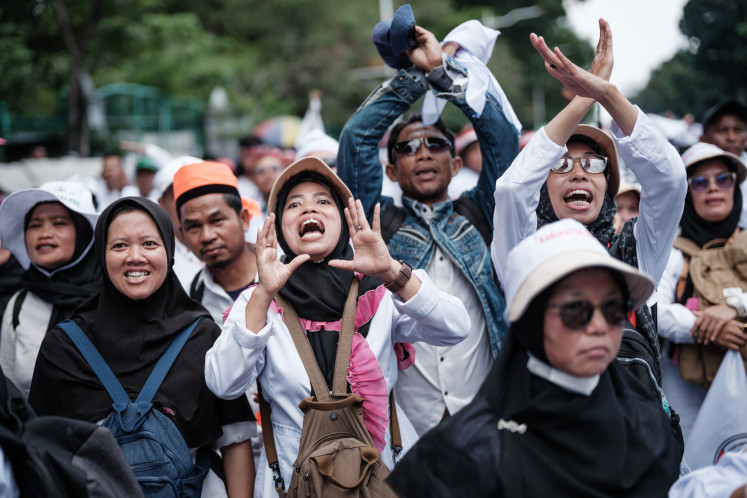Popular Reads
Top Results
Can't find what you're looking for?
View all search resultsPopular Reads
Top Results
Can't find what you're looking for?
View all search resultsKorean food gives Jakarta food for thought
Korean food gives Jakarta FOOD FOR THOUGHTAs the so-called K-wave of Korean pop culture broke on the shores of Indonesia, so did a taste for Korean cuisine
Change text size
Gift Premium Articles
to Anyone
Korean food gives Jakarta FOOD FOR THOUGHT
As the so-called K-wave of Korean pop culture broke on the shores of Indonesia, so did a taste for Korean cuisine.
There are currently at least 150 Korean restaurants in Greater Jakarta, catering to the palates of those hooked on Korean dramas and reality shows ' or on the favorite food of their favorite actors and singers.
Whether we talk about party food such as bulgogi (grilled marinated beef), a full meal like bibimbap, kimbap rice rolls, street snacks such as tteokbokki, seasonal samgyetang (chicken ginseng soup) or the red-bean shaved-ice dessert patbingsoo; Korean food has become familiar to Indonesians.
However, as with the cuisine of other nations that have gained a local foothold, not many Indonesians know about the health value of Korean food.
'I've seen many people leaving out the lettuce and the side dishes while eating meat dishes, Bondan Winarno, the dean of local foodies, said. 'They don't understand that the meat should be wrapped in the lettuce to eat.
Bondan, the author of the best-selling book 100 Makanan Tradisional Indonesia Mak Nyus (100 Traditional Indonesian 'Yummy' Dishes), said that food was an important part of any nation's culture ' and a quick way to understand the lives of others.
'So, let's learn about the food we eat,' he said.
He's been working with the Korean Food Foundation, which recently launched a pocket guidebook in Indonesian, English and Korean to help people in Jakarta get to know their way around Korean cuisine.
The NGO focuses on promoting Korean food and culinary culture and the Korean food industry.
The book, available for free at Gramedia book stores during a promotional period or for download, features 20 select restaurants in Jakarta and 20 in Kuala Lumpur, Malaysia.
Each entry contains testimonials from diners and brief descriptions of the restaurants, their signature dishes, how the food is made and even an estimated cost per person for a meal.
Another Indonesian food expert, William Wongso, and fine artist Lydia Poetrie also shared their experiences with Korean food for the guidebook.
The restaurants selected for the guidebook, which is equipped with extensive maps, all passed a series of impartial appraisals of their food, service, hygiene and interior design.
The appraisal team, which worked for about eight months, picked 35 restaurants in Greater Jakarta for review by Bondan. 'I'd been to nearly all of the restaurants on the list, because my family and I are Korean food lovers. However, I visited each one of them for a thorough review.'
Bondan whittled the list down to 20, bumping some of the list as too pricey, for lacking added value or simply because they were too far away to reach.
The selected restaurants represented different dining styles for patrons of diverse ages and backgrounds, he said.
'I hope this guidebook will make Indonesians be more inquisitive about their own traditional cuisine, because our food, too, is designed with health in mind.'
______________________
The Korean Restaurant Guide-ID,MY is available for free from the Google Play and iTunes app stores or as an ebook or PDF from hansik.org (site search for keyword Indonesia).










